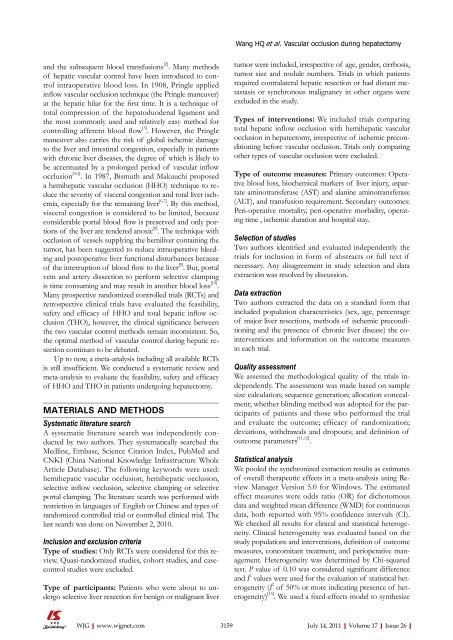26 - World Journal of Gastroenterology
26 - World Journal of Gastroenterology
26 - World Journal of Gastroenterology
You also want an ePaper? Increase the reach of your titles
YUMPU automatically turns print PDFs into web optimized ePapers that Google loves.
and the subsequent blood transfusions [2] . Many methods<br />
<strong>of</strong> hepatic vascular control have been introduced to control<br />
intraoperative blood loss. In 1908, Pringle applied<br />
inflow vascular occlusion technique (the Pringle maneuver)<br />
at the hepatic hilar for the first time. It is a technique <strong>of</strong><br />
total compression <strong>of</strong> the hepatoduodenal ligament and<br />
the most commonly used and relatively easy method for<br />
controlling afferent blood flow [3] . However, the Pringle<br />
maneuver also carries the risk <strong>of</strong> global ischemic damage<br />
to the liver and intestinal congestion, especially in patients<br />
with chronic liver diseases, the degree <strong>of</strong> which is likely to<br />
be accentuated by a prolonged period <strong>of</strong> vascular inflow<br />
occlusion [4,5] . In 1987, Bismuth and Makuuchi proposed<br />
a hemihepatic vascular occlusion (HHO) technique to reduce<br />
the severity <strong>of</strong> visceral congestion and total liver ischemia,<br />
especially for the remaining liver [6,7] . By this method,<br />
visceral congestion is considered to be limited, because<br />
considerable portal blood flow is preserved and only portions<br />
<strong>of</strong> the liver are rendered anoxic [8] . The technique with<br />
occlusion <strong>of</strong> vessels supplying the hemiliver containing the<br />
tumor, has been suggested to reduce intraoperative bleeding<br />
and postoperative liver functional disturbances because<br />
<strong>of</strong> the interruption <strong>of</strong> blood flow to the liver [9] . But, portal<br />
vein and artery dissection to perform selective clamping<br />
is time consuming and may result in another blood loss [10] .<br />
Many prospective randomized controlled trials (RCTs) and<br />
retrospective clinical trials have evaluated the feasibility,<br />
safety and efficacy <strong>of</strong> HHO and total hepatic inflow occlusion<br />
(THO), however, the clinical significance between<br />
the two vascular control methods remain inconsistent. So,<br />
the optimal method <strong>of</strong> vascular control during hepatic resection<br />
continues to be debated.<br />
Up to now, a meta-analysis including all available RCTs<br />
is still insufficient. We conducted a systematic review and<br />
meta-analysis to evaluate the feasibility, safety and efficacy<br />
<strong>of</strong> HHO and THO in patients undergoing hepatectomy.<br />
MATERIALS AND METHODS<br />
Systematic literature search<br />
A systematic literature search was independently conducted<br />
by two authors. They systematically searched the<br />
Medline, Embase, Science Citation Index, PubMed and<br />
CNKI (China National Knowledge Infrastructure Whole<br />
Article Database). The following keywords were used:<br />
hemihepatic vascular occlusion, hemihepatic occlusion,<br />
selective inflow occlusion, selective clamping or selective<br />
portal clamping. The literature search was performed with<br />
restriction in languages <strong>of</strong> English or Chinese and types <strong>of</strong><br />
randomized controlled trial or controlled clinical trial. The<br />
last search was done on November 2, 2010.<br />
Inclusion and exclusion criteria<br />
Type <strong>of</strong> studies: Only RCTs were considered for this review.<br />
Quasi-randomized studies, cohort studies, and casecontrol<br />
studies were excluded.<br />
Type <strong>of</strong> participants: Patients who were about to undergo<br />
selective liver resection for benign or malignant liver<br />
WJG|www.wjgnet.com<br />
Wang HQ et al . Vascular occlusion during hepatectomy<br />
tumor were included, irrespective <strong>of</strong> age, gender, cirrhosis,<br />
tumor size and nodule numbers. Trials in which patients<br />
required contralateral hepatic resection or had distant metastasis<br />
or synchronous malignancy in other organs were<br />
excluded in the study.<br />
Types <strong>of</strong> interventions: We included trials comparing<br />
total hepatic inflow occlusion with hemihepatic vascular<br />
occlusion in hepatectomy, irrespective <strong>of</strong> ischemic preconditioning<br />
before vascular occlusion. Trials only comparing<br />
other types <strong>of</strong> vascular occlusion were excluded.<br />
Type <strong>of</strong> outcome measures: Primary outcomes: Operative<br />
blood loss, biochemical markers <strong>of</strong> liver injury, aspartate<br />
aminotransferase (AST) and alanine aminotransferase<br />
(ALT), and transfusion requirement. Secondary outcomes:<br />
Peri-operative mortality, peri-operative morbidity, operating<br />
time , ischemic duration and hospital stay.<br />
Selection <strong>of</strong> studies<br />
Two authors identified and evaluated independently the<br />
trials for inclusion in form <strong>of</strong> abstracts or full text if<br />
necessary. Any disagreement in study selection and data<br />
extraction was resolved by discussion.<br />
Data extraction<br />
Two authors extracted the data on a standard form that<br />
included population characteristics (sex, age, percentage<br />
<strong>of</strong> major liver resections, methods <strong>of</strong> ischemic preconditioning<br />
and the presence <strong>of</strong> chronic liver disease) the cointerventions<br />
and information on the outcome measures<br />
in each trial.<br />
Quality assessment<br />
We assessed the methodological quality <strong>of</strong> the trials independently.<br />
The assessment was made based on sample<br />
size calculation; sequence generation; allocation concealment;<br />
whether blinding method was adopted for the participants<br />
<strong>of</strong> patients and those who performed the trial<br />
and evaluate the outcome; efficacy <strong>of</strong> randomization;<br />
deviations, withdrawals and dropouts; and definition <strong>of</strong><br />
outcome parameters [11,12] .<br />
Statistical analysis<br />
We pooled the synchronized extraction results as estimates<br />
<strong>of</strong> overall therapeutic effects in a meta-analysis using Review<br />
Manager Version 5.0 for Windows. The estimated<br />
effect measures were odds ratio (OR) for dichotomous<br />
data and weighted mean difference (WMD) for continuous<br />
data, both reported with 95% confidence intervals (CI).<br />
We checked all results for clinical and statistical heterogeneity.<br />
Clinical heterogeneity was evaluated based on the<br />
study populations and interventions, definition <strong>of</strong> outcome<br />
measures, concomitant treatment, and perioperative management.<br />
Heterogeneity was determined by Chi-squared<br />
test. P value <strong>of</strong> 0.10 was considered significant difference<br />
and I 2 values were used for the evaluation <strong>of</strong> statistical heterogeneity<br />
(I 2 <strong>of</strong> 50% or more indicating presence <strong>of</strong> heterogeneity)<br />
[13] . We used a fixed-effects model to synthesize<br />
3159 July 14, 2011|Volume 17|Issue <strong>26</strong>|

















